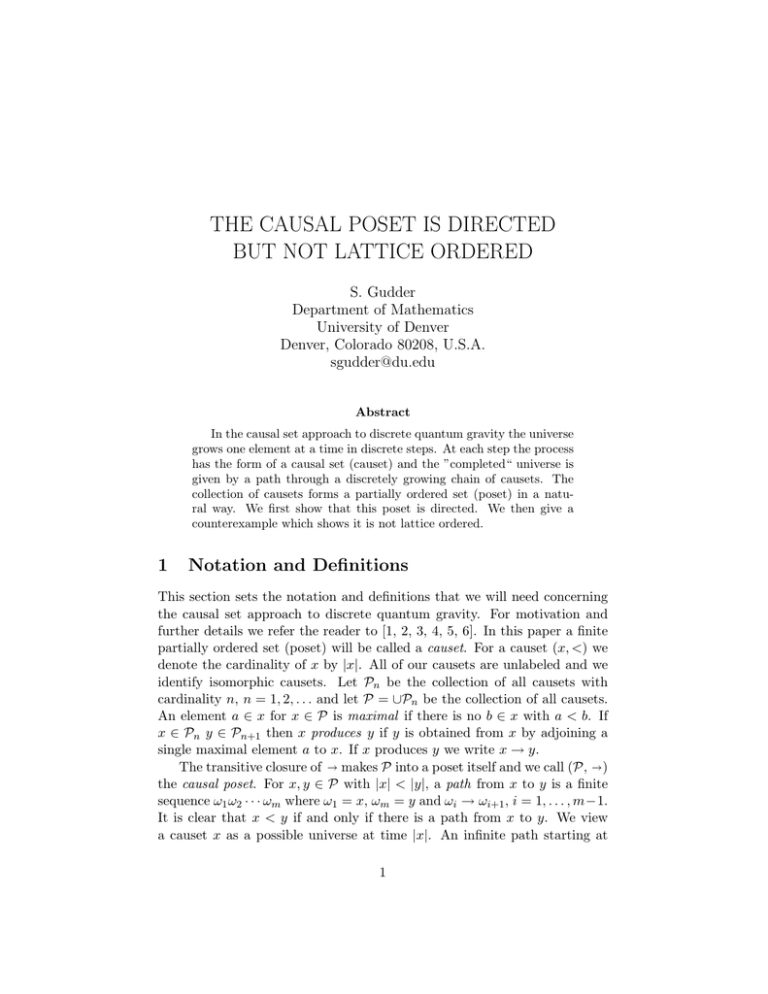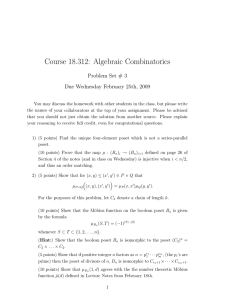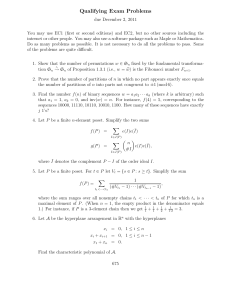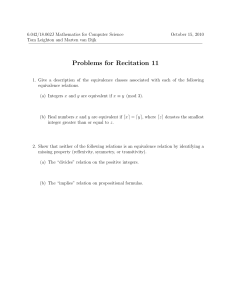the causal poset is directed but not lattice ordered
advertisement

THE CAUSAL POSET IS DIRECTED
BUT NOT LATTICE ORDERED
S. Gudder
Department of Mathematics
University of Denver
Denver, Colorado 80208, U.S.A.
sgudder@du.edu
Abstract
In the causal set approach to discrete quantum gravity the universe
grows one element at a time in discrete steps. At each step the process
has the form of a causal set (causet) and the ”completed“ universe is
given by a path through a discretely growing chain of causets. The
collection of causets forms a partially ordered set (poset) in a natural way. We first show that this poset is directed. We then give a
counterexample which shows it is not lattice ordered.
1
Notation and Definitions
This section sets the notation and definitions that we will need concerning
the causal set approach to discrete quantum gravity. For motivation and
further details we refer the reader to [1, 2, 3, 4, 5, 6]. In this paper a finite
partially ordered set (poset) will be called a causet. For a causet (x, <) we
denote the cardinality of x by |x|. All of our causets are unlabeled and we
identify isomorphic causets. Let Pn be the collection of all causets with
cardinality n, n = 1, 2, . . . and let P = ∪Pn be the collection of all causets.
An element a ∈ x for x ∈ P is maximal if there is no b ∈ x with a < b. If
x ∈ Pn y ∈ Pn+1 then x produces y if y is obtained from x by adjoining a
single maximal element a to x. If x produces y we write x → y.
The transitive closure of makes P into a poset itself and we call (P, )
the causal poset. For x, y ∈ P with |x| < |y|, a path from x to y is a finite
sequence ω1 ω2 · · · ωm where ω1 = x, ωm = y and ωi → ωi+1 , i = 1, . . . , m−1.
It is clear that x < y if and only if there is a path from x to y. We view
a causet x as a possible universe at time |x|. An infinite path starting at
1
the one vertex causet x, is considered to be a ”completed“ universe that
includes its histories.
If a, b ∈ x with x ∈ P we say that a and b are comparable if one of the
following hold: a = b, a < b, b < a. If a and b are not comparable, we say
they are incomparable. Let (P, <) be an arbitrary poset and let A ⊆ P . We
say that b ∈ P is an upper bound for A if a ≤ b for all a ∈ A. The poset P
is directed if for any pair a, b ∈ P , the set {a, b} has an upper bound. We
call P lattice ordered if for any pair a, b ∈ P , the set {a, b} has a least upper
bound. That is, there exists an upper bound c for {a, b} such that c ≤ d
for any upper bound d. In the next section we show that the causal poset
(P, ) is directed, but is not lattice ordered. We interpret this as saying
that for a given time, the paths of any two universes will cross at some later
time.
2
Directed But Not Lattice Ordered
Theorem. P is directed.
Proof. Let x, y ∈ P with |x| = |y|. We can assume that x∩y = ∅. Construct
a path beginning with x and growing one element at a time with the vertices
of y until the path arrives at the causet z = x ∪ y where the vertices of y
are incomparable with all the vertices of x in z (in technical terms, z is the
horizontal sum of x and y). We then have x ≤ z. In a similar way, we can
construct a path from y to z so that y ≤ z. In the other case |x| =
6 |y| we
can assume without loss of generality that |y| < |x|. Form a path beginning
at y and ending at any caused y1 with |y1 | = |x|. Then y ≤ y1 and from
our previous work there exists a z ∈ P with x, y ≤ z. Since y ≤ y1 , we have
that x, y ≤ z.
We now present a counterexample which shows that P is not lattice
ordered. The counterexample is given in Figure 1 which employs the usual
Hasse diagram method for displaying causets . In Figure 1, causets x and
y both produce the distinct causets u and v. Thus u and v are both upper
bounds for x and y. However, there is no smaller upper bound for x and y
so {x, y} has no least upper bound. We conjecture that this is the smallest
counterexample possible.
2
u
v
y
x
Figure 1
References
[1] L. Bombelli, J. Lee, D. Meyer and R. Sorkin, Spacetime as a casual set,
Phys. Rev. Lett. 59 (1987), 521–524.
[2] S. Gudder, Discrete quantum gravity, arXiv: gr-qc 1108.2296 (2011).
[3] S. Gudder, Models for discrete quantum gravity, arXiv: gr-qc 1108.6036
(2011), Rep. Math. Phys. 70 (2012), 15–26.
[4] J. Henson, Quantum histories and quantum gravity, arXiv: gr-qc
0901.4009 (2009).
[5] R. Sorkin, Causal sets: discrete gravity, arXiv: gr-qc 0309009 (2003).
[6] S. Surya, Directions in causal set quantum gravity, arXiv: gr-qc
1103.6272 (2011).
3





